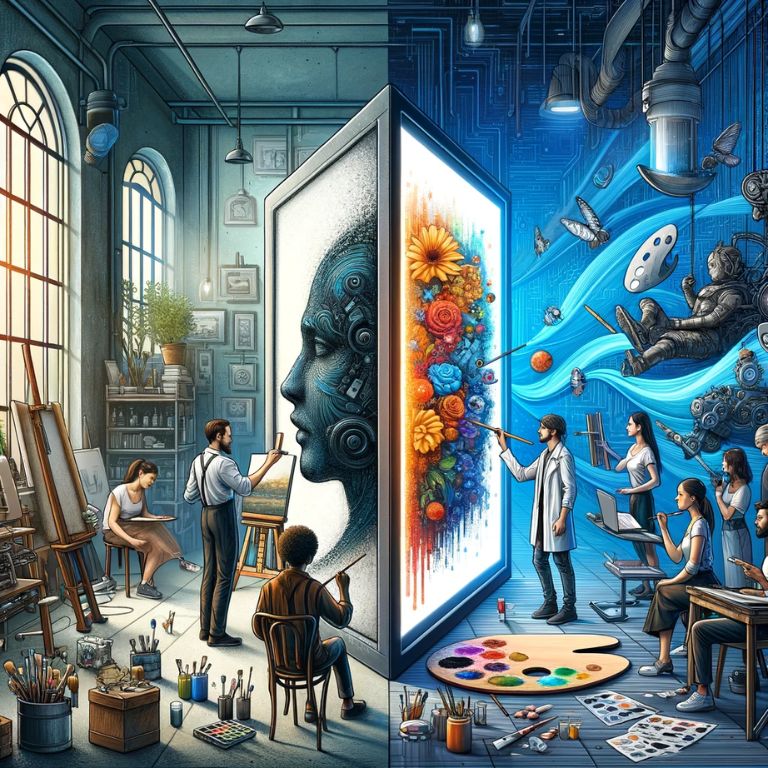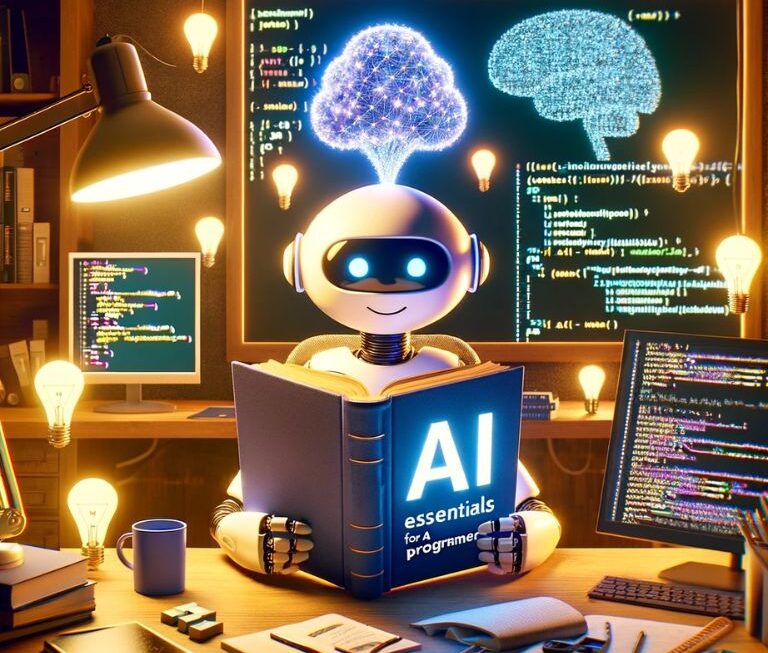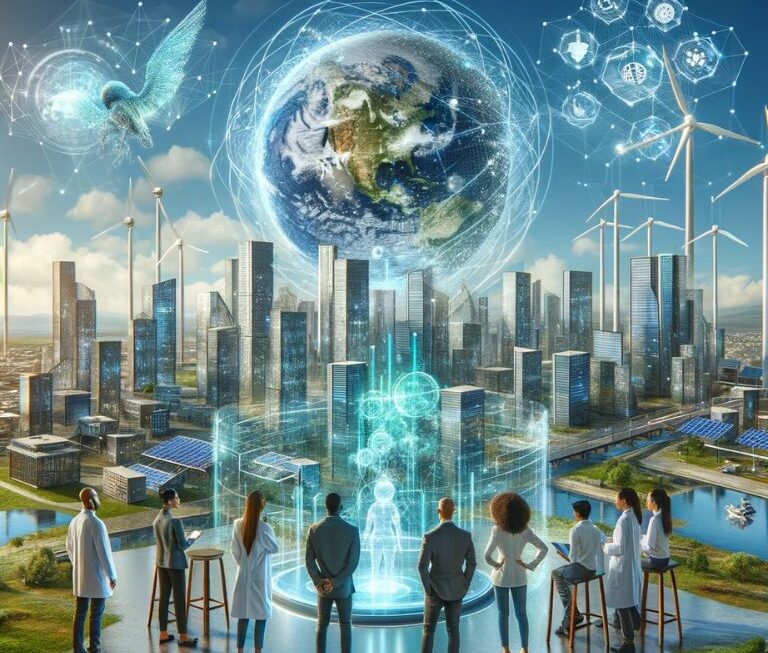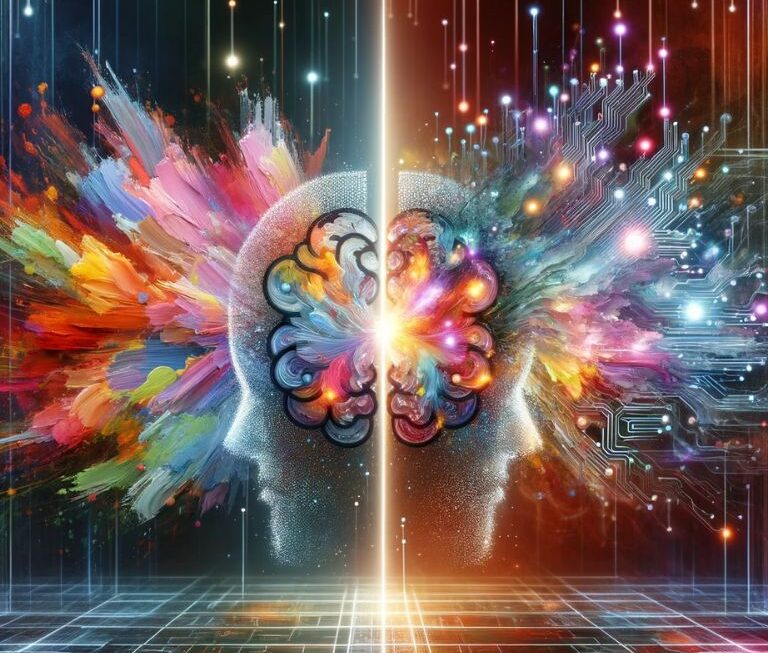The dawn of generative AI has ushered in a new era in the realm of creativity, bringing forth a seismic shift in how art, music, and design are conceived and executed. This innovative technology, rooted in complex algorithms and machine learning, is not just a tool but a collaborator, expanding the boundaries of human imagination and artistic expression.
Defining Generative AI
Generative AI refers to a subset of artificial intelligence focused on creating new content – be it images, sounds, texts, or designs – that previously didn’t exist. It learns from a vast array of existing data, identifies patterns and styles, and then uses this knowledge to generate new, original works. This technology leverages algorithms like Generative Adversarial Networks (GANs), which consist of two parts: a ‘generator’ that creates images, and a ‘discriminator’ that evaluates them. Through constant iteration, the system progressively improves, leading to remarkably sophisticated outputs.
The Emergence of AI in Creative Fields
The integration of generative AI into creative industries has been a gradual yet impactful process. Initially, these technologies found their place in tasks like image and video editing, offering tools that simplified and expedited the creative process. However, their role has since evolved profoundly.
| Year | Milestone in Generative AI | Impact on Creative Industry |
| Early 2000s | Initial development of GANs | Pioneered basic image editing and enhancements |
| 2010-2015 | Advancements in deep learning | Improved quality of AI-generated content; beginnings of AI in music composition |
| 2016-2020 | Rise of user-friendly AI tools | Broad adoption in graphic design, digital art, and video production |
| 2021-Present | AI-driven innovation in art and music | Emergence of AI as a co-creator; AI-generated artworks and music gaining recognition |
As generative AI continues to mature, its capabilities are not just complementing but also challenging traditional creative processes. Artists, musicians, and designers are exploring this technology’s potential to generate new forms of expression and creativity. This journey marks a pivotal chapter in the history of art and technology, where the brushstrokes of human genius meet the precision of machine intelligence, creating a canvas of limitless possibilities.
Historical Context: Before AI in Creativity
Historical creativity predates AI, relying on human ingenuity and skills. Artists and creators developed their craft without the assistance of AI-driven tools and algorithms.
A Look at Traditional Creative Processes
Traditionally, the creative process has been deeply personal and intensely human. It stemmed from individual experiences, emotions, and perceptions. Artists would spend years mastering techniques, exploring different mediums, and drawing inspiration from their surroundings and internal landscapes. This hands-on approach involved a significant investment of time, resources, and, most importantly, personal expression. The creation of art, music, or design was not just about the final product but the journey of exploration, experimentation, and self-discovery.
Contrast with AI-driven Methods
Generative AI introduces a paradigm shift in these traditional methods:
- Speed & Efficiency: AI accelerates creative work, enabling rapid experimentation.
- Data-Driven Inspiration: AI draws from vast datasets for diverse styles.
- Collaborative Creation: AI offers fresh perspectives and ideas to artists.
- Accessibility: Generative AI makes art creation accessible to all.
- Infinite Exploration: AI pushes artistic boundaries and conventions.
- Customization: AI tailors creations to specific needs and preferences.
Generative AI in Visual Arts: A New Palette for Artists
Generative AI revolutionizes visual arts, offering artists a fresh palette. It accelerates creativity, broadens inspiration, and enhances accessibility, shaping a new era of artistic expression.
Examples of AI in Painting, Illustration, and Graphic Design
The realm of visual arts has witnessed a remarkable infusion of generative AI, manifesting in various forms:
- AI-Enhanced Painting: Artists use AI to simulate complex painting styles or create unique patterns, blending traditional techniques with digital innovations.
- Illustration and Character Design: AI tools generate imaginative characters and scenes, providing a starting point or enhancing detailed illustrations.
- Graphic Design and Branding: AI algorithms analyze market trends and design preferences to create logos, layouts, and branding materials that resonate with target audiences.
- Digital Art and NFT Creation: Generative AI is at the forefront of creating digital art pieces, often used in the burgeoning market of Non-Fungible Tokens (NFTs).
- 3D Modeling and Rendering: AI assists in rendering detailed 3D models for architecture, animation, and game design, expediting the creative process.
- Photographic Art: AI transforms photographs into stylized art pieces, employing techniques from classic painting styles to modern graphic effects.
Artist Testimonials on How AI Tools Augment Their Work
Artists who have embraced generative AI in their practice often speak of its transformative impact. They describe AI as a ‘creative catalyst’ that opens new avenues for expression and innovation. One painter noted, “AI helps me break my creative block by suggesting compositions and color schemes I wouldn’t have thought of.” Another digital artist shared, “Using AI is like having a collaborator who brings unexpected ideas to the table; it’s both challenging and inspiring.”
The Symphony of AI: Revolutionizing Music Composition and Production
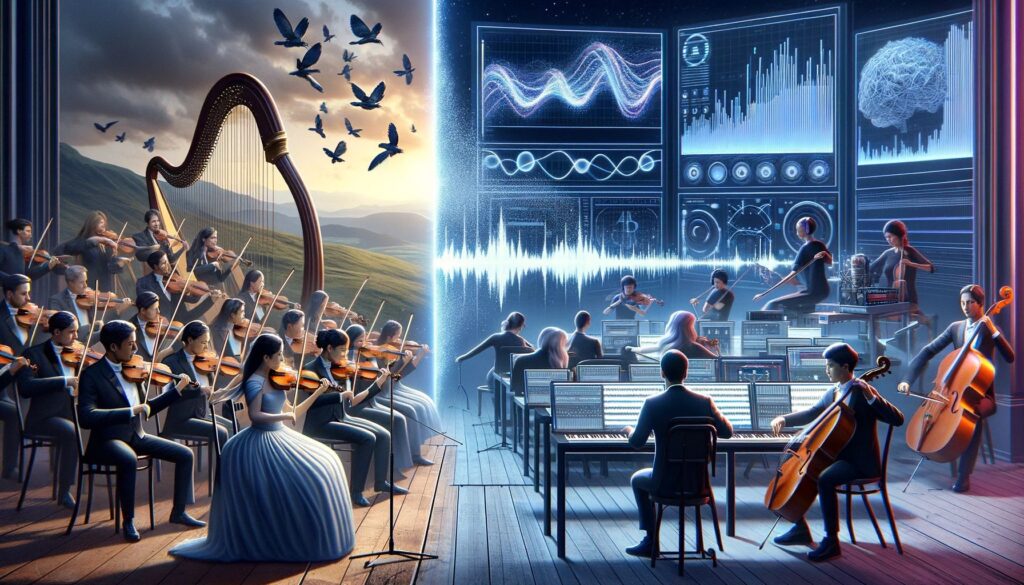
AI in Music Creation
Generative AI has significantly influenced the field of music, as evidenced by several notable case studies:
- AI-Composed Symphonies: AI emulates classical composers like Bach and Beethoven, blending historical styles with AI-generated melodies.
- Electronic Music: AI crafts unique beats and sounds, opening new sonic possibilities in electronic music.
- Interactive Music Apps: AI creates personalized music based on user mood or activity for a customized listening experience.
- Songwriting Collaboration: Songwriters use AI for lyrics, chords, and melodies, enhancing creative collaboration.
- Film Scoring: AI analyzes scenes and mood to compose fitting film scores.
Impact on the Music Industry and Artist Roles
The incorporation of AI in music composition and production has had a profound impact
- Enhanced Creativity: Musicians and composers are using AI to push the boundaries of their creativity, exploring new genres and styles that were previously challenging or impossible to achieve.
- New Revenue Streams: AI-generated music, especially in digital and multimedia applications, is creating new opportunities for monetization and distribution.
- Democratization of Music Production: AI tools make music production more accessible, allowing aspiring musicians and producers with limited resources to create high-quality music.
- Changing Roles of Musicians: Musicians are increasingly becoming curators and editors, focusing on guiding and refining AI-generated music rather than creating every element from scratch.
- Personalization in Music: AI enables a higher degree of personalization in music creation and distribution, tailoring experiences to individual listeners’ preferences.
- Educational Tool: AI serves as a valuable educational tool, helping beginners learn about music composition and theory through interactive, AI-guided platforms.
AI in Design: From Fashion to Architecture
AI is revolutionizing design in fields from fashion to architecture. It enhances creativity, streamlines processes, and offers novel insights, reshaping the future of design disciplines.
Exploring AI’s Role in Various Design Fields
The influence of AI extends across various design disciplines, reshaping the landscape from fashion to architecture. In fashion, designers utilize AI for trend prediction, personalized garment creation, and even generating entirely new styles. In architecture, AI assists in optimizing building layouts, energy efficiency, and even generating creative design solutions that push architectural boundaries. In the realm of graphic design, AI tools are used for creating visually striking and effective designs, automating aspects of layout and color scheme selection. This integration of AI into design not only streamlines the creative process but also opens up new possibilities for innovation and personalization.
Groundbreaking AI-Designed Projects
Several pioneering projects demonstrate AI’s growing influence in design:
- AI-Driven Fashion Collections: Leading fashion brands have experimented with AI to create new collections. One notable example includes a collection where AI algorithms analyzed current fashion trends and consumer preferences to design a series of garments that were both innovative and commercially viable.
- Architectural Wonders with AI: A project in architectural design saw an AI system generating a series of building models that optimized for natural light, energy efficiency, and aesthetic appeal, demonstrating how AI can contribute to sustainable and innovative architectural designs.
- AI in Automobile Design: In the automotive industry, AI has been used to design car models that optimize aerodynamics and aesthetics. This has led to the creation of vehicles with improved performance and fuel efficiency, as well as cutting-edge design.
Human and Machine Collaboration: A New Frontier of Creativity
Human and machine collaboration represents a groundbreaking realm of creativity, where AI accelerates and diversifies artistic expression, enriching the creative process with innovation and efficiency.
Examining Collaborative Works Between AI and Human Creators
The collaboration between humans and AI in the creative process represents a novel and exciting frontier. This partnership has given birth to unique artworks that neither could achieve independently. For instance, in the visual arts, artists are using AI algorithms to generate raw images or patterns, which they then refine or reinterpret to add a personal touch. In music, collaborations have seen AI algorithms generating base melodies or rhythms, with human musicians adding layers, harmonies, or lyrics to complete the composition. This symbiotic relationship between human and machine is not about one leading and the other following; it’s a dance of mutual influence and shared creativity.
Future Possibilities of This Partnership
The potential of human-AI collaboration holds numerous exciting possibilities:
- Enhanced Creative Expression: AI can assist artists in exploring styles or ideas that are beyond their usual scope, leading to more diverse and enriched creative expression.
- Personalized Art and Music Experiences: AI could enable the creation of art or music that adapts in real-time to the emotional responses or preferences of the audience.
- Revolutionizing Film and Theater Production: AI could contribute to scriptwriting, set design, and even real-time special effects, enhancing storytelling in film and theater.
- AI as a Teaching Assistant: In educational contexts, AI could offer personalized guidance, helping students learn and experiment with different creative techniques and styles.
- Collaborative Virtual and Augmented Reality Experiences: AI could play a crucial role in creating immersive virtual and augmented reality experiences, opening new avenues in interactive art and entertainment.
- Bridging Cultural Gaps: AI, with its ability to analyze and learn from diverse cultural artifacts, could assist in creating artworks or performances that bridge cultural differences, fostering greater understanding and appreciation among varied audiences.
Ethical and Cultural Implications of Generative AI in Creativity
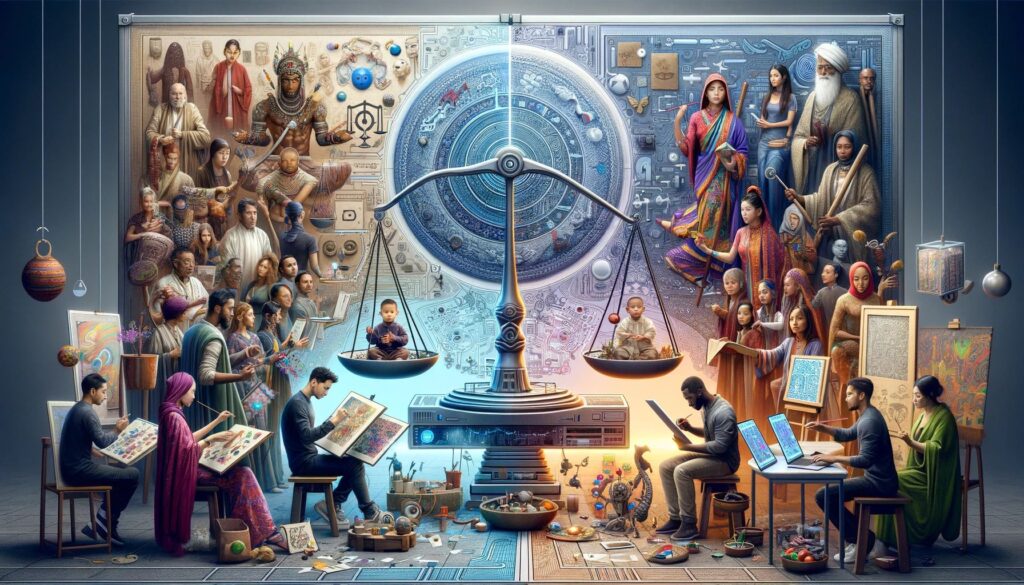
Addressing Concerns About Originality and Authenticity
The emergence of generative AI in creative fields sparks ethical dilemmas surrounding originality and authenticity. Critics argue that AI-generated art may lack human emotional depth. Additionally, concerns about intellectual property and the devaluation of human creativity arise due to AI’s replication capabilities. Striking a balance between AI as a tool and collaborator is crucial, necessitating ethical guidelines to ensure AI enhances human creativity’s value without diminishing it.
The Role of AI in Cultural Production and Preservation
Generative AI has a pivotal role in cultural production and preservation. It democratizes creative expression, fostering diversity and enriching cultural landscapes. Moreover, AI’s ability to analyze and synthesize cultural data aids in preserving endangered art forms, languages, and traditions, ensuring their survival through digital archives and interactive experiences for future generations. Generative AI thus not only creates new cultural content but also safeguards our collective heritage.
Conclusion: The Future Landscape of Creative Industries with AI
Generative AI is revolutionizing the creative landscape, offering a fusion of technology and artistry that is reshaping music, art, and design. This innovative collaboration enhances human creativity, enabling artists to explore uncharted territories of expression. While it raises ethical questions about originality, AI’s potential in democratizing creativity and preserving cultural heritage is undeniable. This new era of AI-driven creativity is not just about technological advancement; it’s about expanding the horizons of human imagination and artistic possibility.

